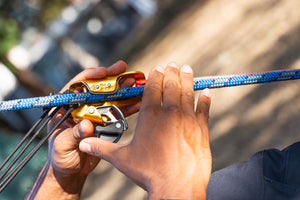


Mastering the Two-Foot Ascending Technique in SRT Climbing
If you're an avid climber, you know that efficiency and technique are keys to success in the world of Single Rope Technique (SRT) climbing. Recently, I came across a fascinating two-foot ascending technique that not only gets the job done but does so with remarkable simplicity. In this blog post, we'll dive into the details of this technique, its setup, and why it's worth adding to your climbing repertoire.
The Two-Foot Ascending Technique Explained
First things first, what's this technique called? Well, it doesn't have a fancy name—it's just the two-foot ascending technique. What makes it special is its straightforwardness and versatility. You won't need an elastic cord over your shoulder or complicated rigging through your bridge ring. Let's break down how it works.
Setting Up Your Two-Foot Ascending Rig
1. Foot Ascender & Knee Ascender: To get started, you'll need a foot ascender for one foot and a knee ascender for the other. I typically store the knee ascender conveniently in my Audax pouch for quick access.
2. Attach and Gradually Load: Clip the knee ascender to your foot loop and attach it to the rope. Gradually shift your weight into the system to allow for attaching your chest harness or tether.
3. The Ascent: Begin your ascent by alternately lifting your feet—left foot, right foot—until you reach your desired height. The simplicity of this technique is what sets it apart; you'll quickly get the hang of it.
Exiting the System:
Leaving the system is just as easy. Sit back in your climbing device, remove the knee ascender from the rope, and stow it away. Don't forget to detach the foot ascender to completely disconnect from the rope. Descend safely to complete your climb.
A Closer Look at the Knee Ascender
Now, if you're wondering about the knee ascender setup, it's often a custom creation. I use a Petzl Croll small ascender positioned at knee height, connected to a DMM accessory via an eye-to-eye tether. This setup provides the necessary elasticity to move up and down the rope efficiently.
On the top end of the ascender, I utilize a captive DMM accessory, which I can easily clip onto the rated loops on the daisy chain running along both shoulders. This feature allows for tension adjustment as needed during your climb.



Convenient Storage
When you're finished with the knee ascender, packing it away is a breeze. Fold it compactly and slide it into the chest pouch on your Audax harness. Zip it up, and it'll stay out of your way until your next climb.

Conclusion
Incorporating the two-foot ascending technique into your SRT climbing repertoire can enhance your efficiency and ease of ascent. It's a simple yet effective approach that works well with various SRT devices. Whether you're an experienced climber or just getting started, this technique is worth trying out.

